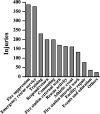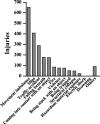1. Yoon J-H, Kim Y-K, Kim KS, Ahn Y-S. Characteristics of workplace injuries among nineteen thousand Korean firefighters. J Korean Med Sci. 2016; 31(10):1546–1552. DOI:
10.3346/jkms.2016.31.10.1546. PMID:
27550481.

2. Houser A, Jackson BA, Bartis JT, Peterson D. Emergency responder injuries and fatalities: RAND Corporation. 2004.
3. Kim TB, Byun HJ, Kang TS. 4M analysis of the factors affecting firefighters' on-site safety. Journal of Korean Society of Occupational and Environmental Hygiene. 2017; 27(3):231–237.
4. Kim DH, An YS, Kim HD, Jeong KS, Ahn Y-S, Kim K-H, Kim Y, Song H-S, Lee C-G, Kwon Y-J. Comparison of facet joint degeneration in firefighters and hospital office workers. Annals of occupational and environmental medicine. 2017; 29(1):24. DOI:
10.1186/s40557-017-0180-1. PMID:
28652921.

5. Kim MG, Kim K-S, Ryoo J-H, Yoo S-W. Relationship between occupational stress and work-related musculoskeletal disorders in Korean male firefighters. Annals of occupational and environmental medicine. 2013; 25(1):9. DOI:
10.1186/2052-4374-25-9. PMID:
24472292.

6. Frost D, Beach T, Crosby I, McGill S. Firefighter injuries are not just a fireground problem. Work. 2015; 52(4):835–842. DOI:
10.3233/WOR-152111. PMID:
26409354.

7. Ide C. Hearing loss, accidents, near misses and job losses in firefighters. Occup Med (Lond). 2007; 57(3):203–209. DOI:
10.1093/occmed/kql180. PMID:
17272301.

8. Kang TS HO, Kim KS, Yoon CS.: Hearing among male firefighters: a comparison with hearing data from screened and unscreened male population. Journal of Exposure Science and Environmental Epidemiology 2015, 01(25(1)):106–112.
9. Agency NEM: Statistics and Data for Fire Disaster Prevention Activities in 2010. In. Edited by Agency NEM, vol. 1. National Emergency Management Agency: National Emergency Management Agency; 2011.
10. Agency NEM: Statistics and data for fire disaster prevention activities in 2011. In. Edited by agency NEM, vol. 1: National Emergency Management Agency; 2012.
11. Agency NEM: Statistics and data for fire disaster in 2012. In. Edited by agency NEM, vol. 1: National Emergency Management Agency; 2013.
12. Agency NEM: Statistics and data for fire disaster in 2013. In. Edited by agency NEM, vol. 1: National Emergency Management Agency; 2014.
13. Labor MoEa: 2014 industrial accident cause statistics report. In. Ministry of Employment and Labor; 2015.
14. Hyun SH, Cha JM, Lee YJ, Song YS, Kim HS, Ahn YS. An analysis on current conditions of occupational casualties of firefighters. Proceedings of the Korea Institute of Fire Science and Eng Conf. 2009:383–91.
15. Ahn YS, Hyun S, Jeong K, Kim K, Choi K, Chae J. The analysis of risk factors related health and safety at disasters and development of special medical health examination system for firefighters. 2011. Seoul: Korea National Emergency Management Agency.
16. Ahn YS. The problem of the compensated injury system of public officials and the lumbar spine of the firefighter compensated injury recognition standards.
2015: the Korean society of occupational and environment. 2015. p. 46–47.
17. Beach TA, Frost DM, McGill SM, Callaghan JP. Physical fitness improvements and occupational low-back loading–an exercise intervention study with firefighters. Ergonomics. 2014; 57(5):744–763. DOI:
10.1080/00140139.2014.897374. PMID:
24689834.
18. Frost DM, Beach TA, Callaghan JP, McGill SM. Exercise-based performance enhancement and injury prevention for firefighters: contrasting the fitness-and movement-related adaptations to two training methodologies. The Journal of Strength & Conditioning Research. 2015; 29(9):2441–2459. DOI:
10.1519/JSC.0000000000000923. PMID:
25763518.
19. Pawlak R, Clasey JL, Palmer T, Symons TB, Abel MG. The effect of a novel tactical training program on physical fitness and occupational performance in firefighters. The Journal of Strength & Conditioning Research. 2015; 29(3):578–588. DOI:
10.1519/JSC.0000000000000663. PMID:
25162645.

20. Sonmez S, Ursavas A, Uzaslan E, Ediger D, Karadag M, Gozu O, Ege E. Sleep disorders and occupational accident in shift work nurses. Chest. 2014; 146(4:947A. DOI:
10.1378/chest.1992342.

21. Gerber M, Hartmann T, Brand S, Holsboer-Trachsler E, Pühse U. The relationship between shift work, perceived stress, sleep and health in Swiss police officers. J Crim Just. 2010; 38(6):1167–1175. DOI:
10.1016/j.jcrimjus.2010.09.005.

22. Özdemir PG, Selvi Y, Özkol H, Aydın A, Tülüce Y, Boysan M, Beşiroğlu L. The influence of shift work on cognitive functions and oxidative stress. Psychiatry Res. 2013; 210(3):1219–1225. DOI:
10.1016/j.psychres.2013.09.022. PMID:
24176594.

23. Dembe AE, Erickson JB, Delbos RG, Banks SM. The impact of overtime and long work hours on occupational injuries and illnesses: new evidence from the United States. Occup Environ Med. 2005; 62(9):588–597. DOI:
10.1136/oem.2004.016667. PMID:
16109814.

24. Buckle P. Ergonomics and musculoskeletal disorders: overview. Occup Med. 2005; 55(3):164–167. DOI:
10.1093/occmed/kqi081.

25. Seabury SA, McLaren CF. The Frequency, Severity, and Economic Consequences of Musculoskeletal Injuries to Firefighters in California. Rand health quarterly. 2012;2(3).











 PDF
PDF Citation
Citation Print
Print



 XML Download
XML Download